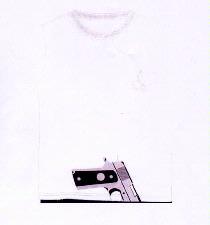Tagged: overall impression
Dispute over a Colt 45 revolver at Alicante’s Community Trademark Court
The producer of “Torrente 4: Lethal Crisis”, one of Spain’s all-time highest grossing films, has been found liable of infringing a registered Community design on the t-shirts used to promote the film.
The comedy tells the adventures of Torrente, an extreme-right-wing, drunkard, sexist and racist Spanish cop. We are not talking about any old film. Distributed by Warner Bross, it was the highest grossing film in Spain in 2011, with box-office sales of over €20 million. It was also the best premiere, only beaten by Pirates of the Caribbean. In fact, Torrente 4 represented none other than 20% of total box-office revenue for Spanish cinema in 2011.
The infringing t-shirts were not sold directly, but were used as merchandising to advertise the release of the movie. The various promotions that were carried out included the joint promotion by Telepizza and Coca Cola. Diablito Vibes, S.L. owner of the infringed design sued the four entities.
The designs compared are obviously not identical, but the Community Trademark Court of Alicante held that the similarities between them met the requirements of the Regulation on Community Designs: “the design does not produce on the informed user a different overall impression”.
The Decision by the Community Trademark Court of Alicante (in Spanish only), concluded that the registered design fulfilled the “novelty” and “individual character” requirements set forth in the Regulation. When comparing the designs it also bore very much in mind the overall impression produced: “This court does not have sufficient knowledge … to assess whether it is the same model of weapon, a Colt 45, but it is undoubtedly the same type of automatic weapon, which reproduces its classical contours and also has spherical shapes on the butt of the revolver (since these are technical requirements or concessions to design) that is darker in color, which are characteristics”.
Finally, it deemed the differences highlighted by the plaintiffs in their defense irrelevant: “the differences that may exist in the weapon model would not appear to be relevant since the impression the product produces on informed users is highly polarized by the presence of a gun and its position and arrangement on a t-shirt. This is particularly true given that even if they are different weapon models, the parts that are visible are clearly similar. The fact that they are facing in different directions is also irrelevant vis-à-vis producing an overall different impression, insofar as this does not cease to conjure up the hypothetical position of a gun hitched into a pair of trousers, to the extent that there is not just one position that achieves this effect since people are both right and left-handed”.
The decision also carries out a very interesting analysis of the entities responsible for the infringement and their degree of responsibility, turning to do so, to the Spanish Industrial Design Law. This law establishes that manufacturers, importers and parties responsible for first putting the infringing design on the market are objectively, directly liable. However, the parties responsible for other types of exploitation “shall only be obliged to provide indemnification for the damage and loss caused if they have been put on notice by authenticated means by the owner of the [design]” and have not acted diligently to avoid it.
The four entities were held liable for infringing the Community design, but only the manufacturer and producer —as licensee of the t-shirt and, as such, responsible for first putting it on the market— were ordered to pay indemnification to Diablito Vives. The decision held that neither Telepizza nor Coca Cola had been “put on notice by authenticated means by the owner of the design”. The producer has been ordered to pay indemnification to the owner of the design in the amount of 1% of the net revenues obtained by the film, which judging by the success of the movie, will not be a small amount.


